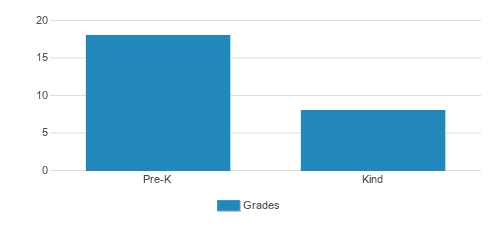Growing Places's mission is to provide quality child care, educational enrichment and youth recreation for children six weeks to 14 years in a safe and caring environment which supports families in raising responsible, respectful and resourceful children.
Our vision is to be a national model for providing exceptional child care, educational enrichment and youth recreations programs, as well as providing training and support for families and educators.
Quick Facts (2025-26)
- School Type: Early Childhood / Day Care
- Grades: Prekindergarten-Kindergarten
- Enrollment: 26 students
- Application Deadline: None / Rolling
- Source: National Center for Education Statistics (NCES)
School Overview
School Type
Grades Offered
Grades Prekindergarten-Kindergarten
Year Founded
1978
School Calendar
Student Body
Total Students
26 students
Student Body Type
Co-ed
Students by Grade

Academics and Faculty
Total Classroom Teachers
2 teachers
Student-Teacher Ratio
13:1
National avg.: 13:1
Tuition and Acceptance Rate
Admission Deadline
None / Rolling
Application URL
School Notes
- Growing Places's mission is to provide quality child care, educational enrichment and youth recreation for children six weeks to 14 years in a safe and caring environment which supports families in raising responsible, respectful and resourceful children. Our vision is to be a national model for providing exceptional child care, educational enrichment and youth recreations programs, as well as providing training and support for families and educators.
Source: National Center for Education Statistics (NCES)
Frequently Asked Questions
What schools are Growing Places often compared to?
Growing Places is often viewed alongside schools like Live & Learn At Mastway by visitors of our site.
When is the application deadline for Growing Places?
The application deadline for Growing Places is rolling (applications are reviewed as they are received year-round).
School Reviews
Endorse Growing Places. Endorsements should be a few sentences in length. Please include any comments on:
- Quality of academic programs, teachers, and facilities
- Availability of music, art, sports and other extracurricular activities
- Academic or athletic awards
Recent Articles

Student Success Predictors at Community Colleges
A practical guide to student success predictors at community colleges for private school advisors helping graduates navigate two-year pathways.

Navigating the FAFSA & Financial Aid Timeline for Community College
Learn how to navigate FAFSA and financial aid timelines when starting at community college — from application to disbursement in 2025.









